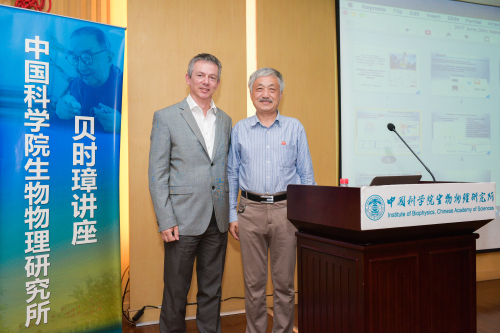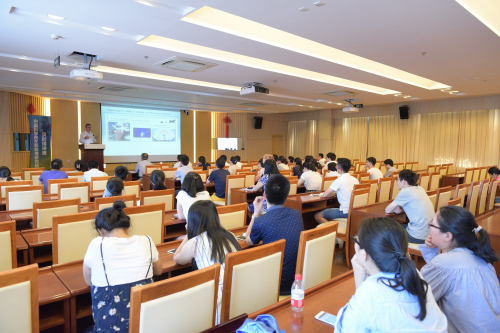Prof. Jürgen G?tz from the Queensland Brain Institute University of Queensland, Visited IBP and Delivered the Shizhang Bei Lecture
On June 26, 2017, Prof. Jürgen G?tz visited Institute of Biophysics and delivered a report entitled " Role of Tau, A? and the kinase Fyn in Alzheimer's disease ". The lecture was a part of the special lecture series named “Shizhang Bei Lecture” at Institute of Biophysics and was hosted by Prof. Rongqiao He.
Professor Jürgen G?tz is a Chairman of Dementia Research Foundation and director of the Clem Jones Centre for Ageing Dementia Research at the Queensland Brain Institute (University of Queensland). It has been long since he engaged in basic research of Alzheimer’s disease (AD) and generated the first tau transgenic mouse model with an early AD phenotype. He also provided evidence for the amyloid cascade hypothesis. These work were published on the most famous journals such as Science and Cell. More recently, his lab developed a novel non-pharmacological treatment of amyloid-depositing and tau-depositing mice using scanning ultrasound (SUS).
In the presentation, Professor Jürgen G?tz first introduced the mechanism and applications of SUS, that combine with Microbubbles IV injection in eliminating Aβ and Tau protein. In summary, the procedure is as follow: 1. Injection microbubbles IV. 2. Applying focused ultrasound. 3. Blood Brain Barrier (BBB) opens. 4. Molecule deposits through the selectively opened BBB areas.
Next, Prof. Jürgen G?tz gave the detailed information on the role of Tau, A? and the kinase Fyn in AD. Tau is a microtubule-associated protein, and Fyn is membrane-associated protein. Somatodendritic accumulation of Tau in AD is induced by oligomeric A? and mediated by the kinase Fyn that activates the ERK/S6 signal pathway. Hyperphosphorylated Tau induces a more depolarized threshold for action potential initiation and reduces firing in hippocampal CA1 neurons. This reduction in neuronal excitability results from a relocation of the axon initial segment (AIS) down the axon in a tau phosphorylation-dependent manner. Stereotaxic infusion of A? into the hippocampus causes Fyn/ERK/S6 activation and Tau overexpression. Overexpression of activated Fyn leads to ERK/S6 activation and Tau accumulation in vivo. Inhibition of Fyn activity abolishes A?-induced Tau increase via ERK/S6 suppression.
Prof. Jürgen G?tz elaborated how Tau is accumulated through induce of A? and mediation of Fyn/ERK/S6 signal pathway, and the effect of accumulation on AIS. Meanwhile, he proposed a novel treatment of amyloid-depositing and Tau-depositing using SUS. Prof. Jürgen G?tz answered many interesting questions raised by the audience. The lecture ended in applause. After the lecture, Prof. Jürgen G?tz discussed further topics with related groups.




